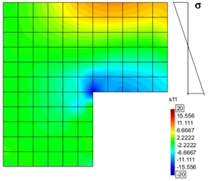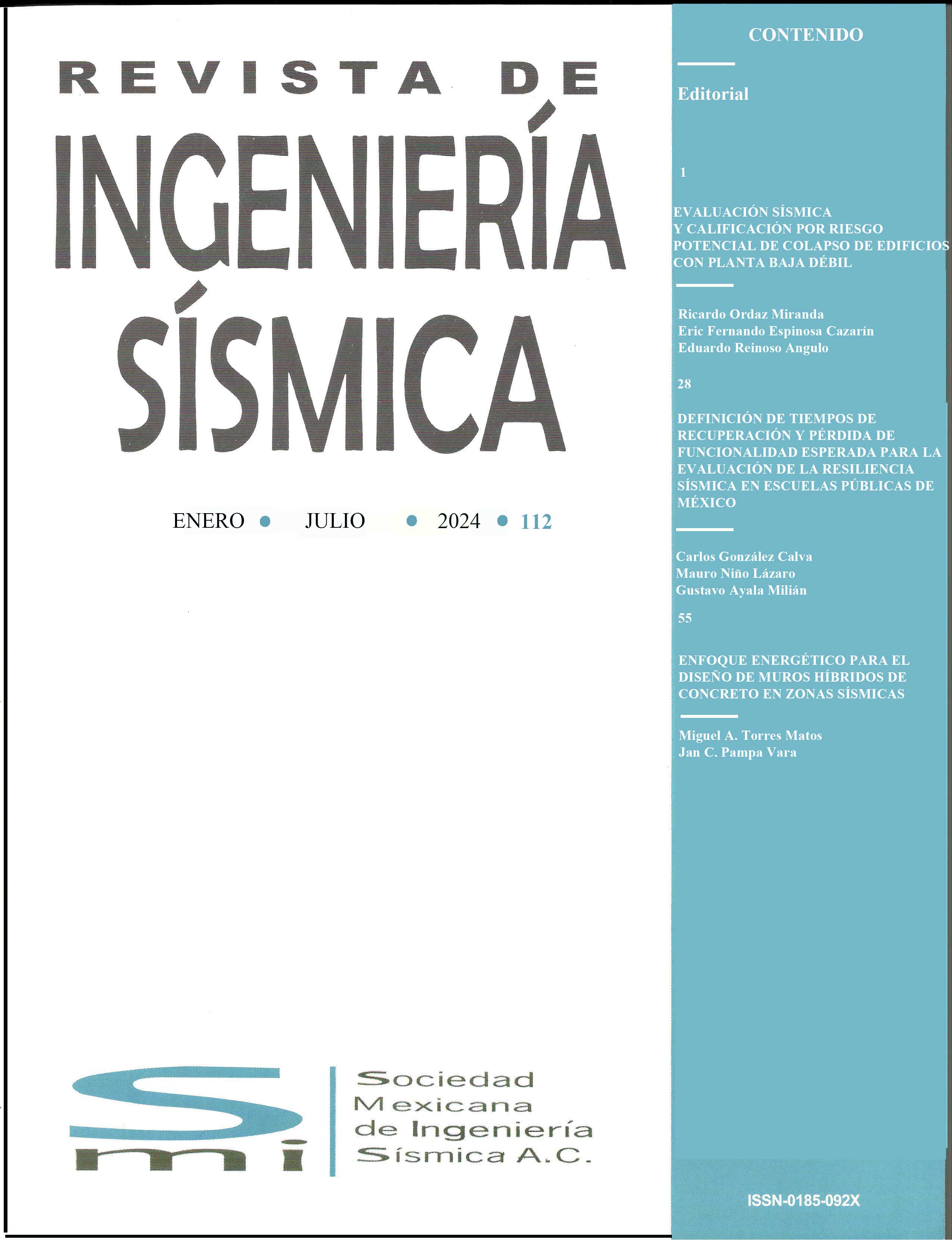APPLICATION OF THE HYBRID SIMULATION APPROACH ON MULTI-SCALE STRUCTURAL ANALYSIS FRAMES
DOI:
https://doi.org/10.18867/ris.114.691Keywords:
hybrid simulation, non-linear analysis, multi-scale problems, steel framesAbstract
This paper presents a general two-scale procedure for the non-linear analysis of structures, taking advantage of hybrid simulation concepts. This proposal considers the coupling and transition between elements of different scales, reducing the degrees of freedom in global analysis by reproducing complex phenomena in local scale models. To manage the interaction of the local models, the hybrid simulation platform, OpenFresco, is proposed for distributing computational work and allowing the interaction between experimental setups and numerical analysis models using different software. The methodology is illustrated through the solution of a linear-elastic system subjected to gravitational and seismic loads, comparing the behavior and analysis time of simplified models, finite element models, and those of the proposed procedure. Finally, to further assess and validate the methodology, the paper presents the pushover analysis of a steel frame, obtaining its capacity curve and showing the tendency of the two-scale method to approximate the results of a refined non-linear finite element model but with a higher computational efficiency.
Downloads
References
Garusi, E. y Tralli, A. (2002). “A hybrid stress-assumed transition element for solid-to-beam and plate-to-beam connections”. Computers & Structures, Vol 80, No 2, pp. 105–115. DOI: 10.1016/S0045-7949(01)00172-9
Huang, X., y Kwon, O. (2020). "A generalized numerical/experimental distributed simulation framework”. Journal of Earthquake Engineering, Vol. 24, No 4, pp. 682-703. DOI: 10.1080/13632469.2018.1423585
Huang, Y., Schellenberg, A., Mahin, S., y Fenves, G. (2008), “Coupling FE software through adapter elements: A novel use of user defined elements”, 10th International LS-DYNA Users Conference, Detroit, MI, Estados Unidos.
Kanber B. y Bozkurt O. (2006). “Finite element analysis of elasto-plastic plate bending problems using transition rectangular plate elements”. Acta Mechanica Sinica, Vol. 22, pp. 355-365. DOI: 10.1007/s10409-006-0012-y
Kwon, O-S., Nakata, N., Elnashai, A.S. y Spencer, B.F (2005). “A Framework for Multi-site Distributed Simulation and Application to Complex Structural Systems”. Journal of Earthquake Engineering, Vol. 9, No 5, pp. 741-753. DOI: 10.1080/13632460509350564
Li, Z., Chan, T. H., Yu, Y. y Sun, Z. (2009). “Concurrent multi-scale modeling of civil infrastructures for analyses on structural deterioration—part I: Modeling methodology and strategy”. Finite Elements in Analysis and Design, Vol. 45, No 11, pp. 782–794. DOI: 10.1016/j.finel.2009.06.013
Maekawa, K., Ishida, T. y Kishi, T. (2009). Multi-scale Modeling of Structural Concrete. Primera ed. Taylor & Francis. DOI: 10.1201/9781482288599
McKenna, F., Fenves, G. y Scott M. (2000), Open System for Earthquake Engineering Simulation, University of California, Berkeley CA. Estados Unidos. http://opensees.berkeley.edu
Mourlas, C., Gravett, D. Z., Markou, G., y Papadrakakis, M. (2019). “Investigation of the soil structure interaction effect on the dynamic behavior of multistorey RC buildings”. VIII international conference on computational methods for coupled problems in science and engineering, Coupled Problems CIMNE, Barcelona, España.
Paniagua, C. y Ayala, A.G. (2023), “Two scale seismic analysis of masonry infill concrete frames through hybrid simulation”. Earthquakes and Structures, Vol. 24, No 6, pp 393-404. DOI: 10.12989/eas.2023.24.6.393
Park, J., Strepelias, E., Stathas, N., Kwon, O. S., y Bousias, S. (2021). “Application of hybrid simulation method for seismic performance evaluation of RC coupling beams subjected to realistic boundary condition. Earthquake Engineering & Structural Dynamics, Vol. 50, No 2, pp. 375-393. DOI: 10.1002/eqe.3335
Pegon, P. y Pinto, A.V. (2000). “Pseudo-dynamic testing with substructuring at the ELSA Laboratory”. Earthquake engineering & structural dynamics, Vol. 29, pp. 905-925. DOI: 10.1002/1096-9845(200007)29:7%3C905::AID-EQE941%3E3.0.CO;2-P
Poliotti, M., Bairán, J.-M., y Möller, O. (2021). “A variable order framework for 3d nonlinear analysis of reinforced concrete frames under general loading”. Engineering Structures, Vol. 242, No 112536. DOI: 10.1016/j.engstruct.2021.112536
Przemieniecki, J. S. (1985). Theory of Matrix Structural Analysis. Primera ed. Dover Publications
Schellenberg, A. H. (2009), “Advanced implementation of hybrid simulation”, PEER Reporte 2009/104 Earthquake Engineering Research Center, University of California, Berkeley, CA, Estados Unidos. https://peer.berkeley.edu/publications/2009-104
Schellenberg, A., Mahin, S. A. y Fenves, G. L. (2006), “Application of an experimental software framework for international hybrid simulation”, 4th International Conference on Earthquake Engineering, Taipei, Taiwan.
Schellenberg, A., Mahin, S. A. y Fenves, G. L. (2007), “A software framework for hybrid simulation of large structural systems”, ASCE Structural Engineering Research Frontiers Congress, Reston, VA, Estados Unidos.
Takahashi, Y. y Fenves, G. L. (2006). “Software framework for distributed experimental–computational simulation of structural systems”. Earthquake engineering & structural dynamics, Vol. 35, No 3, pp. 267-291. DOI: 10.1002/eqe.518
Takeda, T., Sozen, M. A. y Nielsen, N. N. (1970). “Reinforced concrete response to simulated earthquakes”. Journal of the structural division, Vol. 96, No 12, pp. 2557–2573. DOI: 10.1061/JSDEAG.0002765
Taucer, F., Spacone, E. y Filippou, F. C. (1991). “A fiber beam-column element for seismic response analysis of reinforced concrete structures”, Reporte UCB/EERC-91/17. Earthquake Engineering Research Center, University of California, Berkeley, CA, Estados Unidos. https://nisee.berkeley.edu/elibrary/Text/237794
Wang, F., Xu, Y. y Qu, W. (2014). “Mixed-dimensional finite element coupling for structural multi-scale simulation”. Finite Elements in Analysis and Design, Vol. 92, pp. 12–25. DOI: 10.1016/j.finel.2014.07.009
Weinan, E. (2011), Principles of Multiscale Modeling. Primera ed. Cambridge University Press. https://assets.cambridge.org/97811070/96547/frontmatter/9781107096547_frontmatter.pdf
Yue, J. G., Fafitis, A., Qian, J., y Lei, T. (2011), “Application of 1D/3D finite elements coupling for structural nonlinear analysis”, Journal of Central South University of Technology, Vol. 18, No 3, pp. 889-897. DOI: 10.1007/s11771-011-0778-3

Downloads
Published
How to Cite
Issue
Section
License
Copyright (c) 2025 Journal Earthquake Engineering

This work is licensed under a Creative Commons Attribution-NonCommercial 4.0 International License.





